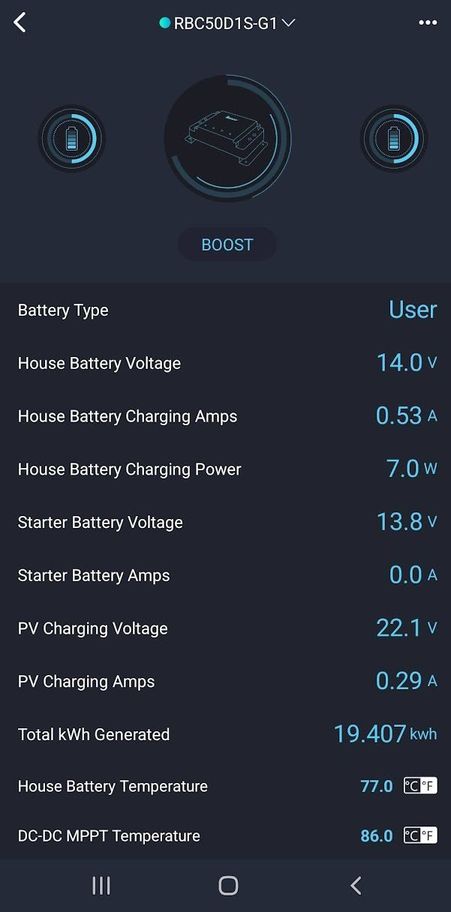reading solar tea leaves
what is the MPPT doing?
 DC sent a screencap of how her DC-DC charger was doing (quite well, thankyouverymuch). Let’s see what we can glean. First some info about the system.
DC sent a screencap of how her DC-DC charger was doing (quite well, thankyouverymuch). Let’s see what we can glean. First some info about the system.
the gear
- 100Ah Chins LiFePO4
- Renogy DCC50 50A DC-DC w/MPPT
- 2x 100w Grape Solar poly framed panels mounted on the roof. In parallel since the DCC has a PV input limit of 25v.
configuration
- 14.0v Absorption (“boost”) for a few minutes
- 13.4v Float
- pic taken with engine on
status
The “House Battery” lines tell us the battery is at 14.0v and charging at 0.53A. But this could be because the battery is Very Nearly Full or because the system has just enough juice to hold absorption voltage (Vabs). Which is it?
what the alternator says
The “Starter Battery” lines tell us about alternator contribution. In this case 0.0A. This controller is solar-biased, preferring to let solar meet needs if possible.1 So either then engine isn’t running (it was) or that solar charging was sufficient to meet demand. So we know the battery is Very Nearly Full.
what the panel voltage says
But wait, there’s more! Panel voltage (Vpanel) also tells us something, and that something is informative whether we are talking about built-in MPPT or a standalone controller. We normally see three modes of MPPT-controller interaction
- Vpanel ~= Vmp - controller is maxxing out the panels. Normally Vmp is depressed a bit below spec Vmp due to cell temp derating, but close enough.
- Vpanel > Vmp - controller is limiting current from the panels
- Vpanel ~= Vbatt - rarer to see, but it genearally means light is so low there is not enough juice to run the controller
We see from the spec sheet that the Vmp on these panels is 18.0v. The “PV” section of the app shows Vpanel is 22.1v, so we know the controller has its foot almost completely off the gas pedal. The controller would have dropped to Float within seconds or minutes of the screenshot being taken.
Folks curious about this kind of geekery can see more in this RVwiki article.
I broke my shunt
I had a cheap 75A shunt for measuring current in the system. That worked fine when I was running smaller loads. Today I was messing around in the battery box, moving the inverter cables. I forgot to turn off the loads and when I hooked the shunt back up the inrush smoked the shunt. :-(
I don’t feel the need for a $130 Victron Smart Shunt. I might not need a shunt at all:
- just before I smoked the shunt I noted the JBD BMS in the Rebel LiFePO4 coulomb counting agreed with the shunt within 1 percentage point, so I don’t need counting for capacity
- I also observed that (as expected) the larger 100Ah batt takes about 2/3rd of the current, so I don’t need current observation
- the Victron SmartBatterySense senses voltage, so I don’t need that either
Maybe if I can pick up an openbox SmartShunt for $50 I’ll think about it.
UPDATE - I woke up at 2am the other night and realized I might have disrupted the B+ connection the shunt uses for its own electronic circuit. I moved everything out of the way and yep that was it. Good thing I didn’t buy a replacement.
comments
mastodon comment thread for this post
-
the Kisae DMT1250 is alternator-biased by default ↩
